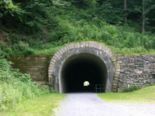Staple Bend Tunnel
The Staple Bend Tunnel was the first railroad tunnel in the United States of America. Constructed for the Allegheny Portage Railroad section of the Pennsylvania Main Line of Public Works, it is located at a bend in the Little Conemaugh River. The tunnel began its life allowing access to horse-drawn rail carriages, hauling canal boats to and from Johnstown and Hollidaysburg. Later, steam locomotives took the same cargo through it. Once replaced by newer rail lines, the tunnel began its period of disuse, finally being closed up and used to carry water pipe. In the last decade, it has seen a revival in the National Park System, reopened and repaired, allowing bicyclists and hikers through it.
Construction
Its location was decided by Sylvester Welch, Principal Engineer for the Allegheny Portage Railroad.[1] It was designed by James Appleton and Thomas Etherington Appleton, who were contracted for both the tunnel and for Section 7 of the Railroad on May 25, 1831. Construction began on April 12, 1831, with Samuel Jones as superintendent and Solomon Roberts as the overseeing engineer. Three-man crews of Irish workers dug from each end, carving nine to ten holes before Welsh miners spooned blasting powder in. After detonation, usually around lunchtime, the mucker crews would spend the rest of the day removing the rubble. Approximately 14,900 cubic yards of bedrock were removed. While excavation connected the sides of the tunnel on December 21, 1832, and final excavation of the interior was completed in April 1833, it was not until June 1833 that final work on the tunnel was finished.[1] It was opened for service on October 7, 1834. The total cost of construction was $37,498.85. Each opening was built with sandstone facades in the Roman Revival style (while only the west facade remains, it is believed that a twin version was built on the other end, but removed prior to 1889). The tunnel was lined with cut stone for the first 150 feet on either end.[2] For the remainder of its length, the natural rock was left exposed. The full length of the tunnel is 901 feet; its interior width and height is 20 feet by 19 feet.
Use and Disuse
The Staple Bend Tunnel operated as part of the Allegheny Portage Railroad until December 1852, when it was abandoned in favor of the New Portage Railroad. It was sold to the Pennsylvania Railroad along with the rest of the Allegheny Portage Railroad (original and new) on June 25, 1857. The rails were removed in 1858. It began to be used as a local roadway until around 1889.[1]
The tunnel began to be used as a water system in the early 1900s with a 42" wood stave water pipe laid through it. Also around this time, the two entrances were closed up, and doors put in. In 1951, the Bethlehem Steel Corporation laid a 48" water pipe through the tunnel, and had a water vault structure on the west end, roughly where the incline engine house stood during the railroad period. Sometime in this period, the east entry arch had a concrete lining added on the inside.[3] This provides structural support, as that portion of the tunnel has deformed.
Revival in the Park System
In the 1990s, the tunnel was transferred from Bethlehem Steel to the National Park Service. The tunnel was restored by Graciano for the National Park Service, finishing the work on March 22, 2000.[4] It currently sits on about two miles of trail, and is administered by the Allegheny Portage Railroad National Historic Site (there are plans for expanding the trail to eight miles). Portions of the trail have the original sleeper stones, sandstone blocks onto which the rails were fitted.

